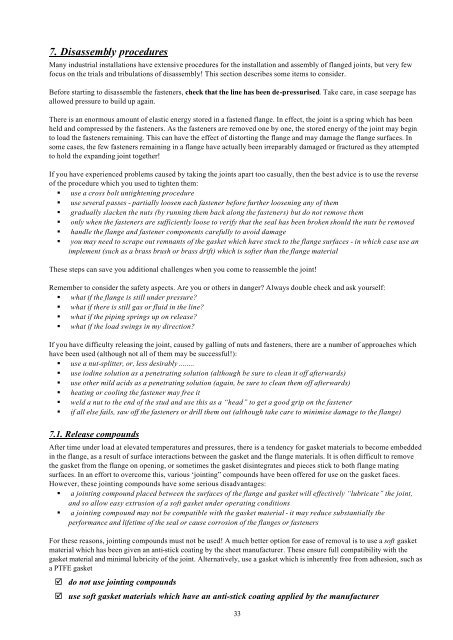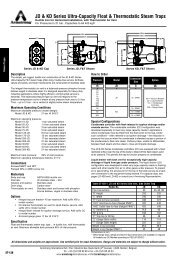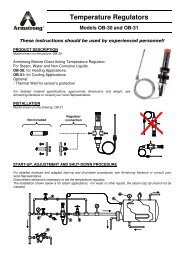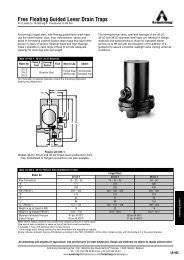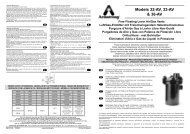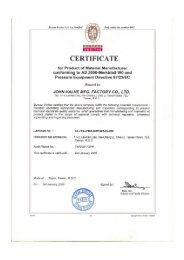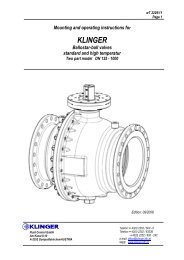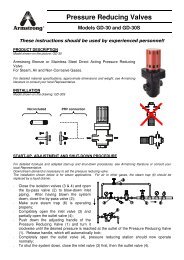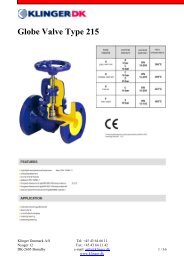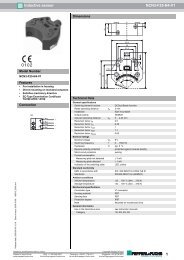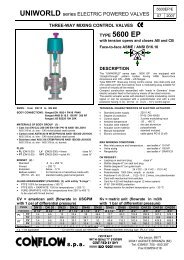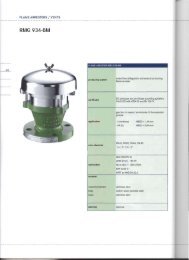Guidelines for safe seal usage - Klinger AG Egliswil
Guidelines for safe seal usage - Klinger AG Egliswil
Guidelines for safe seal usage - Klinger AG Egliswil
Create successful ePaper yourself
Turn your PDF publications into a flip-book with our unique Google optimized e-Paper software.
7. Disassembly procedures<br />
Many industrial installations have extensive procedures <strong>for</strong> the installation and assembly of flanged joints, but very few<br />
focus on the trials and tribulations of disassembly! This section describes some items to consider.<br />
Be<strong>for</strong>e starting to disassemble the fasteners, check that the line has been de-pressurised. Take care, in case seepage has<br />
allowed pressure to build up again.<br />
There is an enormous amount of elastic energy stored in a fastened flange. In effect, the joint is a spring which has been<br />
held and compressed by the fasteners. As the fasteners are removed one by one, the stored energy of the joint may begin<br />
to load the fasteners remaining. This can have the effect of distorting the flange and may damage the flange surfaces. In<br />
some cases, the few fasteners remaining in a flange have actually been irreparably damaged or fractured as they attempted<br />
to hold the expanding joint together!<br />
If you have experienced problems caused by taking the joints apart too casually, then the best advice is to use the reverse<br />
of the procedure which you used to tighten them:<br />
• use a cross bolt untightening procedure<br />
• use several passes - partially loosen each fastener be<strong>for</strong>e further loosening any of them<br />
• gradually slacken the nuts (by running them back along the fasteners) but do not remove them<br />
• only when the fasteners are sufficiently loose to verify that the <strong>seal</strong> has been broken should the nuts be removed<br />
• handle the flange and fastener components carefully to avoid damage<br />
• you may need to scrape out remnants of the gasket which have stuck to the flange surfaces - in which case use an<br />
implement (such as a brass brush or brass drift) which is softer than the flange material<br />
These steps can save you additional challenges when you come to reassemble the joint!<br />
Remember to consider the <strong>safe</strong>ty aspects. Are you or others in danger? Always double check and ask yourself:<br />
• what if the flange is still under pressure?<br />
• what if there is still gas or fluid in the line?<br />
• what if the piping springs up on release?<br />
• what if the load swings in my direction?<br />
If you have difficulty releasing the joint, caused by galling of nuts and fasteners, there are a number of approaches which<br />
have been used (although not all of them may be successful!):<br />
• use a nut-splitter, or, less desirably ........<br />
• use iodine solution as a penetrating solution (although be sure to clean it off afterwards)<br />
• use other mild acids as a penetrating solution (again, be sure to clean them off afterwards)<br />
• heating or cooling the fastener may free it<br />
• weld a nut to the end of the stud and use this as a “head” to get a good grip on the fastener<br />
• if all else fails, saw off the fasteners or drill them out (although take care to minimise damage to the flange)<br />
7.1. Release compounds<br />
After time under load at elevated temperatures and pressures, there is a tendency <strong>for</strong> gasket materials to become embedded<br />
in the flange, as a result of surface interactions between the gasket and the flange materials. It is often difficult to remove<br />
the gasket from the flange on opening, or sometimes the gasket disintegrates and pieces stick to both flange mating<br />
surfaces. In an ef<strong>for</strong>t to overcome this, various ‘jointing” compounds have been offered <strong>for</strong> use on the gasket faces.<br />
However, these jointing compounds have some serious disadvantages:<br />
• a jointing compound placed between the surfaces of the flange and gasket will effectively “lubricate” the joint,<br />
and so allow easy extrusion of a soft gasket under operating conditions<br />
• a jointing compound may not be compatible with the gasket material - it may reduce substantially the<br />
per<strong>for</strong>mance and lifetime of the <strong>seal</strong> or cause corrosion of the flanges or fasteners<br />
For these reasons, jointing compounds must not be used! A much better option <strong>for</strong> ease of removal is to use a soft gasket<br />
material which has been given an anti-stick coating by the sheet manufacturer. These ensure full compatibility with the<br />
gasket material and minimal lubricity of the joint. Alternatively, use a gasket which is inherently free from adhesion, such as<br />
a PTFE gasket<br />
þ do not use jointing compounds<br />
þ use soft gasket materials which have an anti-stick coating applied by the manufacturer<br />
33


